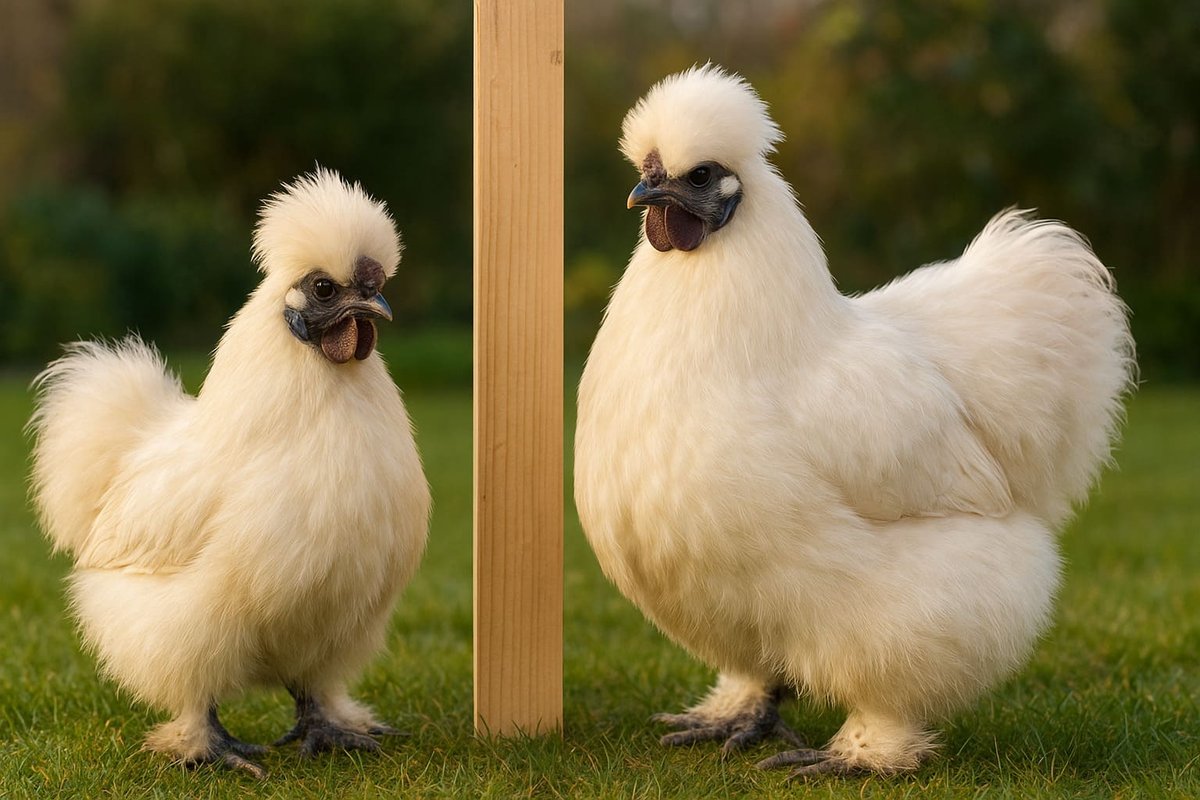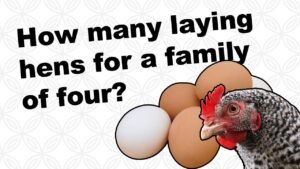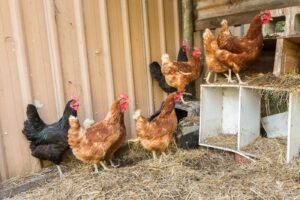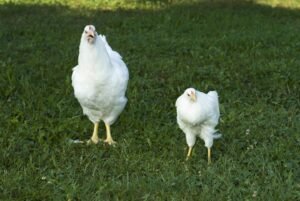Choosing your first Silkie chicken, sometimes known as the Chinese silk chicken, can feel like stepping into a fluffy, feathered cloud of confusion. I remember when I first decided to add Silkies to my small flock. I was set on the idea of having a tiny, friendly bantam breed, but then I saw a photo of a magnificent, full-sized, Standard Fowl Silkie. Suddenly, I was stuck. Which one was the right fit for my backyard?
It’s the question that every aspiring Silkie owner asks: Silkie Bantam vs Standard Silkie—what’s the real difference? The truth is, while they look almost identical, their size changes everything about how you care for them. We’re going to compare Bantam Silkies vs Large Fowl Silkie across all the key areas: size, personality, egg-laying, and what they need to stay healthy. Whether you’re interested in them as docile pets or for exhibition, understanding these differences is the first step in successful small-scale poultry farming.
The most important difference is exactly what their names suggest: size. A Silkie bantam is a True Bantam, meaning it is a naturally small or miniature breed of chicken, while the standard version is the Large Fowl Silkie, representing the breed’s standard, larger size. Although the standard is the original size, the Silkie bantam is much more popular today. They share the same unique traits—fluffy feathers, dark blue skin (a trait known as Fibromelanosis), five toes (a condition called Polydactly), and intense broodiness. This guide will help you confidently choose between the two.
Size and Characteristics: The Core Difference
The primary difference is their size and weight, which affects almost every other aspect of their care. When people ask, “What is the difference between bantam Silkies and standard Silkies?”, they are talking about this size disparity. It’s important to note that not all Silkies are bantams; only the smaller variety is the Silkie bantam.
Bantam Silkie: Small, Compact, and Adorable
The Silkie bantam is the more common type, ideal for families and urban chicken keepers. In the United States, this is the only variety of Silkie officially recognized for competition by the American Poultry Association (APA).
- Weight: As defined in the APA’s bantam standard, a mature cock should weigh 36 oz (≈1 kg), and a hen should weigh 32 oz (≈910 g). My own bantam rooster, Pip, is a perfect example, weighing in at exactly 35 ounces.
- Height: They stand about 8 to 11 inches (20 to 28 cm) tall.
- Visual Look: They maintain a signature, round, puffy appearance. Their short legs and small bodies make them look like moving cotton balls. Bantam chicks are especially fragile but grow into easily managed adults.
The European “Large Fowl” Silkie
The Standard or “Large Fowl” Silkie is not recognized for exhibition in the United States but is a standard size in Europe.
- Weight: A mature Standard rooster weighs about 4 pounds (1.8 kg), and a hen weighs 3 pounds (1.36 kg)—substantially larger than a bantam. To put that in perspective, a Standard hen weighs almost as much as a small bag of flour! My Standard hen, Pearl, is a healthy 3.2 pounds and feels significantly heavier to hold.
- Height: They stand about 10 to 14 inches (25 to 35 cm) tall.
- Visual Look: They look like a larger, fluffier version of their smaller cousins. While considered “large fowl” for the breed, they are still small compared to giants like the Brahma or Cochin.
Unique Physical Traits Beyond Fluff
Beyond their famous feathering, all Silkies share several distinct features:
- Walnut Comb: Instead of a typical single comb, they have a small, almost circular comb that is often dark mulberry or black in color.
- Turquoise Earlobes: A surprising splash of color, their earlobes are a beautiful bright turquoise blue.
- Five Toes (Polydactyly): Most chicken breeds have four toes, but Silkies have a fifth toe on each foot. The fifth toe should be separate from the others and point upward.
Actionable Tip: Showing Your Silkies
If you plan to show your Silkies in the United States, you will be working exclusively with the bantam variety. The APA and American Bantam Association (ABA) only list the bantam Silkie for competition. Judges look for an ultra-compact body, a short back, a globular crest, and perfect tail carriage according to the official breed standard.
In summary, the size difference is the most defining factor between the two types of Silkies, influencing everything from coop space to feed costs. Now that you understand the physical distinctions, let’s dive into the fascinating genetics that make a Silkie so unique.
Genetics, Color, and Unique Traits
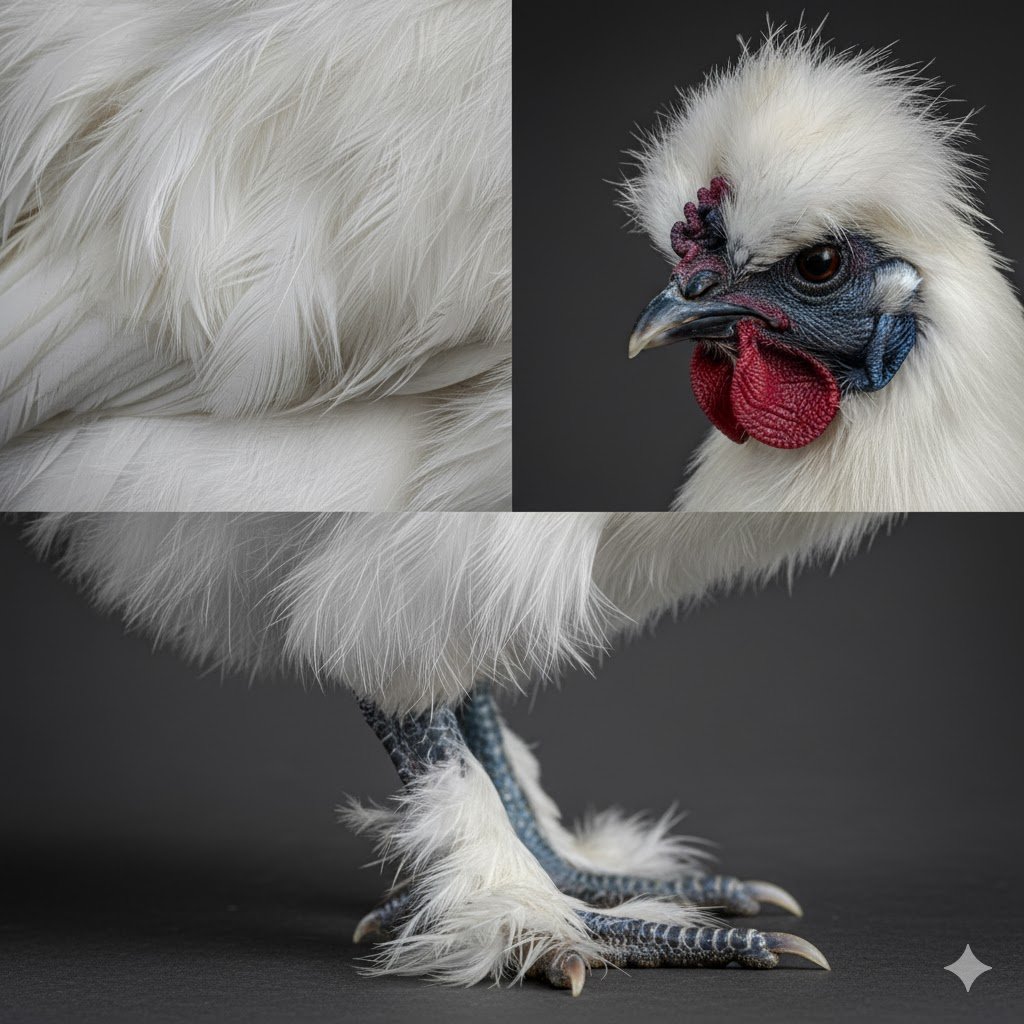
Beyond their friendly demeanor, Silkies possess fascinating genetic traits that truly set them apart. Their key characteristics are controlled by specific genes:
- Hookless (Silkie) Feathering: This is controlled by the recessive
hlocus. - Fibromelanosis (Dark Skin): This trait is governed by the dominant
Fmgene. - Polydactyly (Five Toes): This correlates with regulatory variation in the
Shh(Sonic hedgehog) gene.
The Secret to Their Fluff: The Hookless Feather Gene
A common question is, “What is unique to the Silkie bantam breed?” The answer lies in their feathers. Silkies carry a recessive gene that results in Hookless Feathers (gene symbol: h). This gene removes the barbicels—tiny hooks that interlock to create the smooth, flat surface of a normal feather. Without barbicels, their plumage resembles downy fluff or fur, which is incredibly soft to the touch.
Silkie Genetics and Satin Variants
A standard Silkie’s fluffy appearance comes from having two copies of the recessive hookless feather gene (h/h). However, there is another variant known as the Satin Silkie. Satins are genetically Silkies in every way (crest, five toes, dark skin) but have smooth, shiny feathers because they do not have the h/h gene combination. While Satins are not exhibited as “Silkies,” they may be shown in other featherleg classes at some poultry shows. Always check your specific show’s catalog and rules for how they are classified.
Less Common and Project Varieties
In the US, the APA/ABA-recognized bantam Silkie varieties include Black, Blue, Buff, Gray, Partridge, Splash, White, and Self Blue (lavender). The term “rarest” is difficult to apply, as popularity is regional and changes over time. However, some varieties are considered “less common” or are part of dedicated breeding “project” programs. These include:
- Cuckoo: A barred pattern of black and white.
- Paint: A white bird with black spots.
- Chocolate: A rich, deep brown color, which is a dilution of black.
Finding a breeder specializing in these project colors can be a challenge but is rewarding for enthusiasts.
Understanding the genetics of a Silkie’s appearance is key, but it’s their famously gentle personality that truly captures hearts. Let’s explore how their temperament makes them one of the most beloved backyard chicken breeds.
Temperament and Behavior
Both varieties are famous for having gentle and friendly personalities. This gentle nature isn’t just anecdotal. Research into chicken genomics (e.g., studies on the effects of domestication on behavior published in journals like Poultry Science) has identified specific genetic markers linked to temperament, with breeds like the Silkie consistently noted for their docile behavior and low aggression.
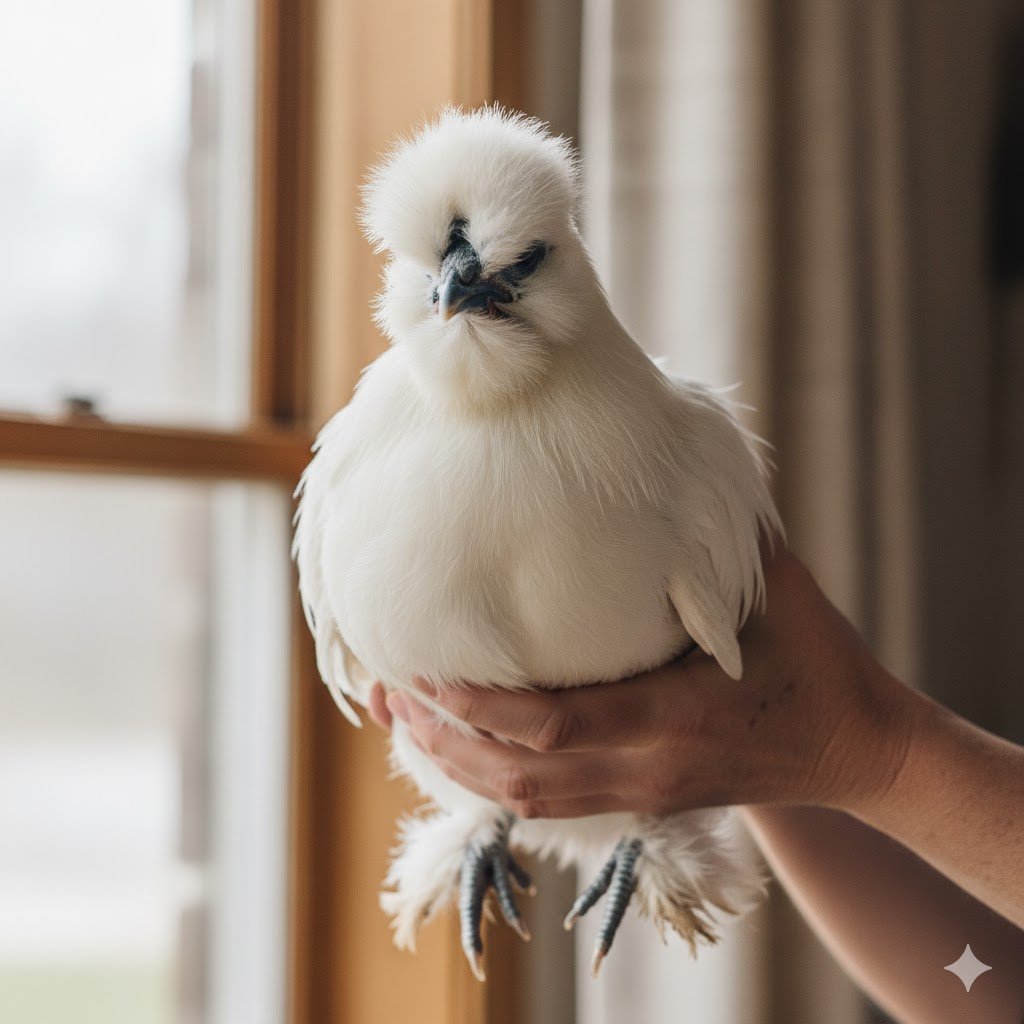
Silkie Bantam Temperament
- Cuddling Potential: Can you cuddle Silkie chickens? A resounding yes! Their small size makes them easy to pick up and hold, and their soft feathers are comforting. They are more likely to jump onto a lap or shoulder.
- Noise Levels: Are silkie bantam chickens noisy? No, not usually. Silkies, in general, are known for being quiet. The bantam rooster’s crow is far less booming than a standard rooster’s, making them an excellent choice for urban areas with noise restrictions.
Standard Silkie Temperament & Flock Dynamics
The Standard Silkie is equally gentle, but their larger size gives them more confidence. In a mixed flock, a Standard Silkie can hold its own slightly better against other small breeds. However, both types are typically at the bottom of the pecking order due to their vision-obscuring crests.
- Flight Ability: Can Silkie bantams fly? No. As confirmed by research from institutions like Ohio State University, the “hookless” feathering lacks barbicels, the tiny structures that lock feather strands together. This structural difference makes it impossible for their feathers to trap air and create the lift required for flight. Silkies are completely ground-bound.
Integrating Silkies into a Mixed Flock: A Step-by-Step Guide
Because of their gentle nature and poor vision, integrating Silkies requires care.
- Quarantine First: Always keep new birds separate for at least 30 days to monitor for illness.
- Visual Introduction: Place the new Silkies in a crate or pen inside the main flock’s run for several days. This allows the flock to see them without physical contact.
- Supervised Meetings: Allow them to mingle for short periods under close supervision, preferably in a large space with lots of distractions.
- Provide Hiding Spots: Ensure there are places where a Silkie can retreat from a more assertive hen.
- Choose Flock Mates Wisely: Avoid keeping Silkies with large, aggressive breeds. They do best with other docile bantam breeds.
Actionable Tip: Managing Broodiness
Both Silkies share an intense desire to sit on eggs. To manage this:
- Remove the Hen Immediately: The moment you see her glued to the nesting box (a classic Silkie characteristic), move her.
- Use a “Broody Jail”: Place her in a wire-bottom cage with food and water but no bedding for two to three days. This is a common method to break a broody hen. The air circulation cools her belly, which helps break the maternal instinct.
A Silkie’s sweet and calm demeanor makes them a joy in any flock, but how do they compare to other small breeds? Understanding these differences will help you decide if a Silkie is truly the right fit for you.
Comparison with Other Bantam Breeds
To understand where Silkies fit in the wider world of small chickens, it helps to compare them to other popular bantam breeds.
- Vs. Cochin Bantams: Like Silkies, Cochin bantams are known for being exceptionally calm, friendly, and prone to broodiness. However, Cochins have standard feathers (making them more weather-resistant) and fully feathered feet. They are another excellent choice for a family pet, offering a different but equally fluffy look.
- Vs. Sebright Bantams: Sebrights are the opposite of Silkies in temperament. They are active, flighty, and not at all cuddly. Sebrights are a “true bantam” prized for their beautiful, laced feather pattern and confident posture, making them a top-tier exhibition bird rather than a backyard pet.
- Vs. d’Uccle Bantams: Belgian d’Uccle bantams are friendly and curious, similar to Silkies. They are known for their beards, muffs, and heavily feathered feet (“booted”). While they can be handled, they are generally not as famously docile as Silkies.
While Silkies are prized for their personality over their productivity, they do lay eggs and are fantastic mothers. Next, let’s set realistic expectations for what you’ll find in the nesting box.
Egg Production and Mothering
Silkies are primarily Ornamental, meaning they are kept for their appearance, exhibition qualities, and gentle personalities rather than for high egg or meat output (Production). It’s important to keep expectations modest for egg-laying.
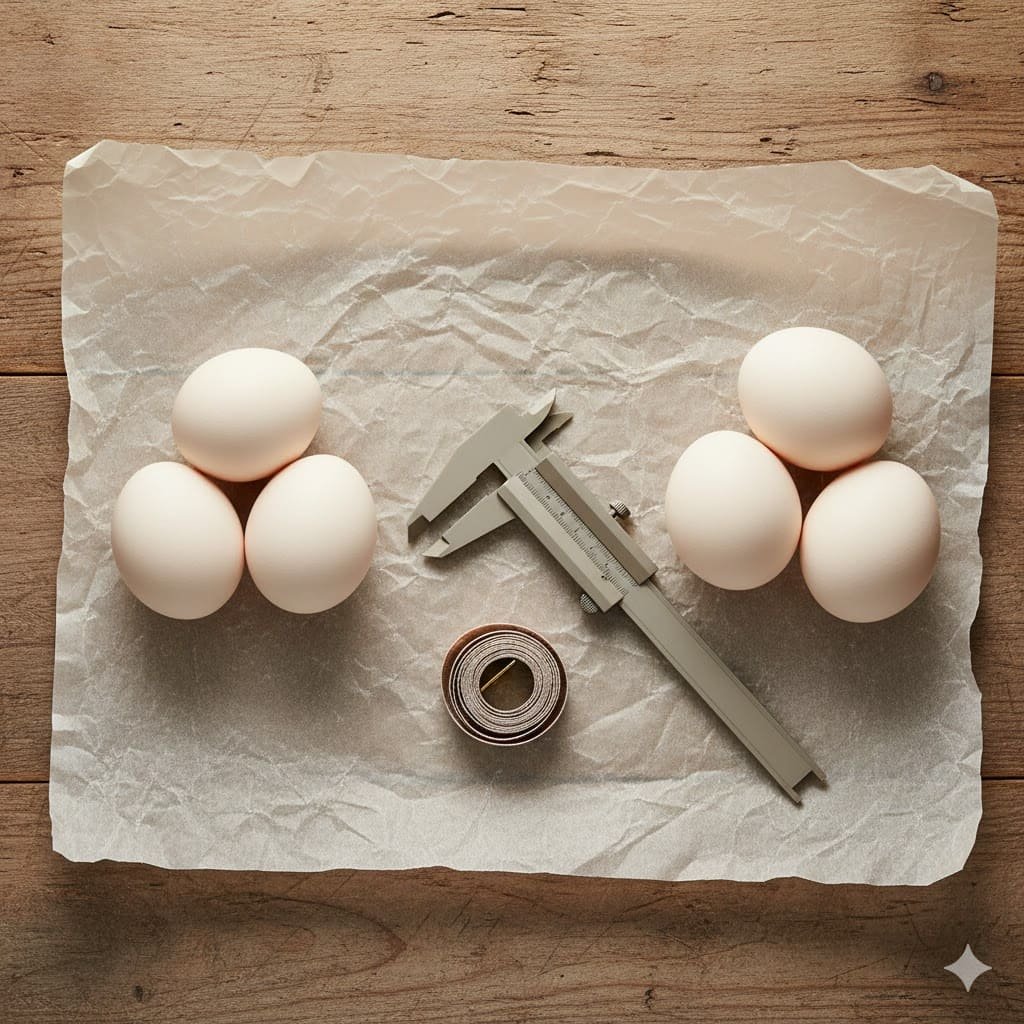
Egg Laying Comparison
A healthy Silkie hen will lay around 100-120 small, cream-colored eggs per year.
- Bantam Egg Production: Lays very small eggs. The smaller bantam size also means less feed is consumed.
- Standard Egg Production: Lays small-to-medium eggs that are about 25% larger than a bantam’s.
Most Silkies are active layers for about 2-3 years before production declines.
Hatching with Silkies
If you plan to use a Silkie hen as a natural incubator, size is a key consideration:
- Standard Silkie: Can comfortably cover 8-10 standard chicken eggs.
- Silkie Bantam: Can only cover about 5-7 standard eggs.
Using Your Silkie as Nature’s Incubator
Their intense broodiness makes them the best natural incubators. You can slip eggs from other, less broody hens under a Silkie, and she will happily raise them as her own. They are such dedicated mothers that they have even been known to hatch ducklings and goslings.
A Silkie’s value clearly lies in more than just eggs, but keeping them healthy requires special attention to their unique needs. Let’s cover the essential health and care practices to ensure your fluffy friend lives a long, happy life.
Health, Care, and Lifespan
Both varieties are relatively hardy, but their unique features create specific health needs. With proper care, a Silkie’s lifespan is commonly 7 to 9 years.
Silkie-Specific Health Issues
- Crest and Vision: The fluffy crest can block a Silkie’s vision. Avian veterinarians universally recommend trimming the feathers around the eyes so the bird can see clearly to find food, water, and spot predators.
- Feather Type and Wet Weather: The down-like feathers are not waterproof. If a Silkie gets soaked, they can suffer from hypothermia. Reputable veterinary sources, including the Merck Veterinary Manual, stress the importance of a completely dry, draft-free coop for this breed.
- Vaulted Skull: Some crested breeds, including Silkies, can have a “vaulted skull,” which is a morphological trait related to the crest genetics (specifically the HOXC10 region). In some birds, this can result in an incomplete or unsealed skull, leaving the brain more vulnerable to injury from a sharp peck or hard impact. However, not all Silkies have a dangerous cranial vault; susceptibility varies greatly. It is a key reason why they should always be kept with other gentle breeds.
Marek’s Disease: A Critical Concern
Silkies are known to be particularly susceptible to Marek’s disease, a common and deadly poultry virus.
- What it is: A viral disease that causes tumors and paralysis in chickens.
- Prevention: There is no cure, so prevention is key. It is highly recommended to purchase chicks that have been vaccinated for Marek’s at the hatchery.
Seasonal Care Differences
Their non-waterproof feathers and dense plumage require special attention throughout the year.
- Summer Care: Both varieties can be prone to heat stress. Their fluffy feathers make it difficult for them to cool down. Always provide deep shade, cool fresh water, and well-ventilated coops. Bantam Silkies, with their smaller body mass, can be particularly susceptible to overheating.
- Winter Care: This is the most critical season. A wet Silkie is a cold Silkie, which can quickly become fatal. Their coop must be completely dry and free of drafts. Standard Silkies have a slight advantage due to their larger body mass, which helps them retain heat better, but both are at extreme risk if their feathers become damp from snow or rain. Ensure their run is covered or mud-free to keep them from getting wet.
Actionable Health Management
- Preventing Respiratory Illnesses: Use nipple drinkers or low-set water cups to prevent them from dunking their heads. A coop with excellent ventilation can help prevent respiratory infections.
- Worming and Parasite Control: Perform routine foot checks once a month and ensure they always have access to a deep, dry dust bath. Their dense fluff can be a haven for mites and lice, so regular checks are crucial.
Disclaimer: This is general husbandry info; consult a poultry veterinarian for diagnosis/treatment.
Proper health management is the foundation of good chicken keeping. To support their health, you’ll need the right equipment and environment, which we’ll detail next.
Recommended Supplies & a Silkie Starter Kit
To ensure your Silkies start off on the right foot, here is a list of recommended supplies. Putting these together creates a perfect starter kit.
- Feeder: A low-profile, anti-waste feeder prevents them from scratching out their food. Look for models with covers to keep feed clean.
- Waterer: A poultry nipple waterer or a shallow dish is essential. Silkies can easily get their crests soaked in standard waterers, leading to chills.
- Coop: A secure, dry, and draft-free coop is non-negotiable. Ensure it has good ventilation to prevent respiratory issues.
- Bedding: Use absorbent bedding like pine shavings or hemp to keep the coop floor dry.
- Feed: Start chicks on a high-quality starter/grower crumble. For adults, switch to a quality layer pellet or crumble.
- Grooming Kit: A small pair of blunt-nosed scissors is crucial for safely trimming feathers away from your Silkie’s eyes.
With the right supplies in hand, you can create the perfect home for your new flock. Let’s move on to the specific housing and feeding requirements for each Silkie size.
Housing and Feeding
While care is similar, the difference in size means their housing and feeding needs vary.
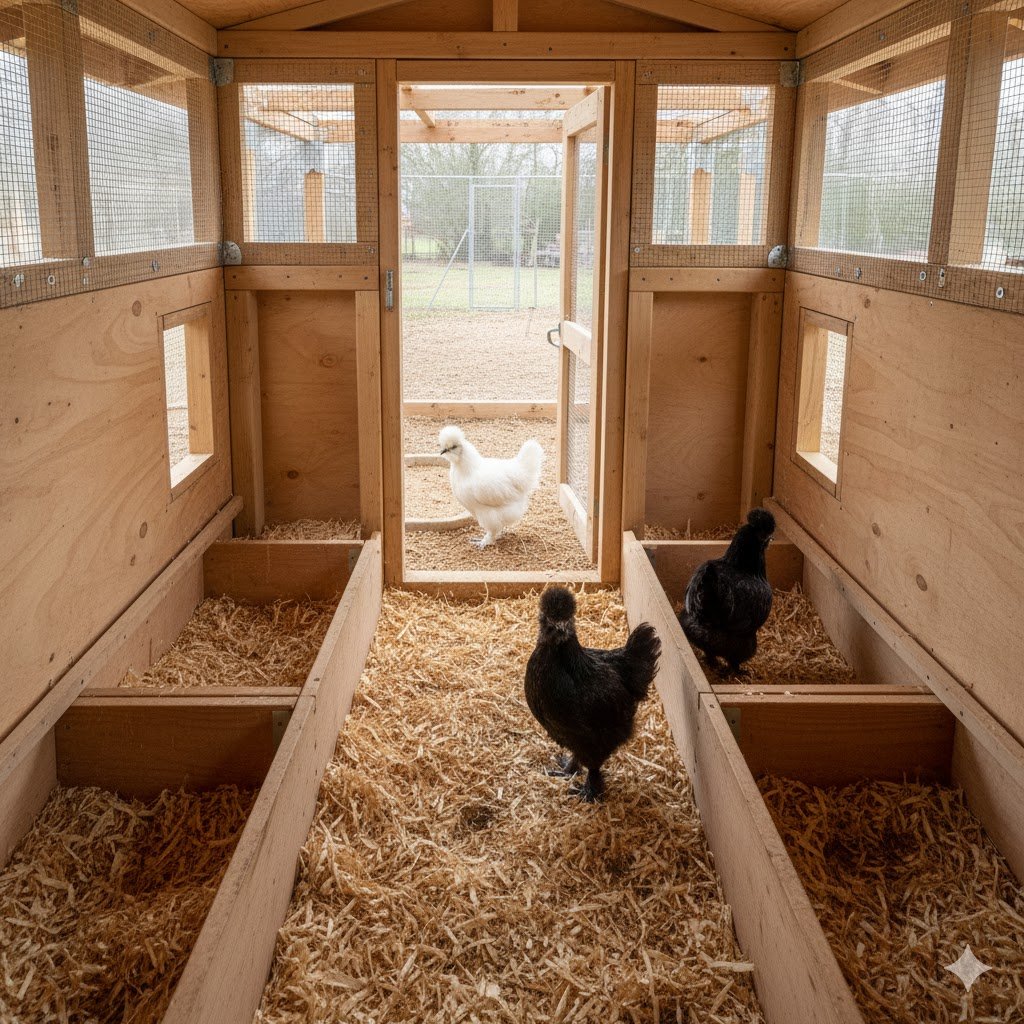
Housing Needs Comparison
| Feature | Silkie Bantam Needs | Standard Silkie Needs | Why the Difference? |
|---|---|---|---|
| Coop Space | Min. 2 sq ft (0.18 sq m) per bird | Min. 3 sq ft (0.28 sq m) per bird | Standards are larger and need more space to prevent stress. |
| Run Space | Min. 5 sq ft (0.46 sq m) per bird | Min. 8 sq ft (0.74 sq m) per bird | More ground to cover for exercise. |
| Nesting Box | Small, ground-level boxes preferred | Medium, ground-level boxes preferred | Ground-level access is vital for their short legs. |
Designing the Perfect Silkie Coop
- Low Roosting Bars: Silkies cannot fly, so roosting bars should be no more than a foot off the ground.
- Covered Run: Their feathers are not waterproof, so a covered run is essential to protect them from rain and snow.
- Excellent Ventilation: Good airflow prevents moisture buildup, which is critical for preventing respiratory illness and keeping their feathers dry.
Feeding Requirements
- Bantam Diet: Bantams need smaller pellets or crumbles. They consume significantly less feed. In my own flock, my three bantams collectively eat about half a cup of a high-quality crumble each day. My single Standard hen eats nearly that much all by herself, highlighting the difference in feed costs over time.
- Health Tip: In a mixed flock, ensure the smaller Silkie bantam has its own safe feeding station.
Space Considerations for Urban Keepers
For those practicing urban chicken keeping, the Silkie bantam is the clear choice. A flock of three Silkie bantams can comfortably live in a smaller backyard space than even two Standard Silkies.
Now that you know how to house and feed your Silkies, it’s time to consider the financial commitment. Let’s break down the costs and what to look for when you decide to buy.
Cost Analysis and Breeding
Before committing, it’s wise to understand the costs involved.
Initial Purchase Price
Price depends heavily on quality (pet vs. exhibition), and prices vary by location and breeder availability.
| Category | Silkie Bantam Price (Average) | Standard Silkie Price (Average) |
|---|---|---|
| Hatchery Chick | $4 – $10 USD | $6 – $12 USD |
| Show Quality Adult | $50 – $150+ USD | $75 – $200+ USD |
Ongoing Care Costs and Purpose
- Feed Cost: Because bantams are smaller, their feed costs are significantly lower over their lifespan.
- Purpose & ROI: For an ornamental purpose, the ROI is intangible—measured in the enjoyment and therapeutic benefits of pet ownership. For a small-scale production purpose (eggs), the ROI is minimal. A hen might lay ~10 dozen small eggs a year. At an average of $5/dozen for farm eggs, that’s roughly $50/year per hen, which will likely be offset entirely by feed and care costs. The true ‘profit’ comes from selling hatching eggs or chicks, which requires a deeper investment in breeding quality stock.
Finding a healthy, well-bred Silkie is the most important investment you can make. The next section will guide you on where to find the perfect fluffy addition to your family.
Where to Find Silkies for Sale
Finding healthy, well-bred Silkies is key to a good experience.
Breeder Directories and Poultry Clubs
The best source is often a reputable local breeder. You can find them through breed clubs and directories:
- American Silkie Bantam Club: An excellent resource for finding dedicated breeders in the US.
- American Bantam Association (ABA) & American Poultry Association (APA): Both organizations have member directories where you can search for breeders who specialize in Silkies.
Reputable National Hatcheries
If a local breeder isn’t an option, some national hatcheries offer Silkie chicks. While convenient, quality can vary.
Finding a Reputable Breeder
- Check Poultry Clubs: Members of national associations like the American Bantam Association and American Poultry Association are typically serious about breed standards. As a member of the ABA myself, I’ve found that breeders involved with these clubs are not only knowledgeable but also passionate about preserving the integrity of this heritage poultry breed.
- Inquire About Bloodlines: A good breeder will know the history of their birds. I found my best birds not from a large hatchery, but from a small, family-run breeder named “Featherfoot Farms” that I met at a local poultry show. They were passionate about their flock’s health and were happy to answer all my questions.
- Consult the Standards: To truly understand what breeders are aiming for, consider purchasing the “American Standard of Perfection” (for Large Fowl) or the “Bantam Standard” (for bantams). These books are the official guides used by judges and are invaluable for any serious enthusiast.
With all this information, you’re nearly ready to make a decision. Let’s summarize the key advantages and disadvantages of the Silkie bantam to help you make your final choice.
Final Pros and Cons: Silkie Bantam
| Pros (Advantages) | Cons (Disadvantages) |
|---|---|
| Ideal Pets: Incredibly docile and a perfect size for kids. | Vulnerable: Small size and vaulted skull make them targets. |
| Quiet: Low noise levels are perfect for urban settings. | Highly Broody: Frequent broodiness leads to low egg production. |
| Low Feed Cost: Eat significantly less than standard breeds. | Fragile in Bad Weather: Feathers are not waterproof. |
| Long Lifespan: Can live 7 to 9+ years with proper care. | Small Eggs: Requires 2-3 bantam eggs to equal one large egg. |
The pros and cons list provides a quick overview, but the best choice depends entirely on your specific situation and goals. This final summary will help you decide.
Final Breed Selection Summary
- Choose the Silkie Bantam if: Your goal is urban chicken keeping in a small space, and you prioritize a super-friendly pet above all else.
- Choose the Standard Silkie if: You have a bit more space, want the benefit of a slightly larger egg, and prefer a bird that can hold its own better in a mixed flock (even if they are not for exhibition in the US).
Regardless of your choice, both the Silkie bantam and the standard will bring immense joy and a wonderfully docile personality to your backyard.
Frequently Asked Questions (FAQ) on Silkie Bantam vs Standard Silkie
Q: Are all Silkies bantams?
A: In the US show system, Silkies are officially listed only as bantams. The large fowl Silkies are a standard size found in Europe.
Q: What’s the real difference in size and weight?
A: A bantam Silkie weighs 36 oz (cock) and 32 oz (hen). A large fowl Silkie from Europe weighs approximately 4 lb (cock) and 3 lb (hen).
Q: Can Silkie bantams fly?
A: No, not in any meaningful way. Their unique “hookless” feathers lack the structure to create lift for flight.
Q: What is a vaulted skull?
A: It is a crest-linked cranial feature seen in some Silkie lines where the skull may be incompletely fused. The risk of injury varies significantly by the bird’s specific genetics.
Q: What colors are recognized in the US?
A: The recognized bantam varieties are Black, Blue, Buff, Gray, Partridge, White, Self Blue (lavender), and Splash.
Q: How many eggs do Silkies lay?
A: They lay roughly 100–120 small, cream-colored eggs per year, though their intense broodiness often interrupts this cycle.
Q: Are Satins “Silkies”?
A: Genetically, they are very similar, but they have smooth feathers and are not considered Silkies for exhibition. Some poultry shows may bench “Satin” as a separate class—always check the show catalog.
Conclusion: Making Your Final Fluffy Choice
Congratulations! You now have the expert knowledge needed to choose between a Silkie bantam and a Large Fowl Silkie.
Remember, choosing a Silkie chicken means welcoming a truly unique and special bird into your life. You are not choosing a high-output egg layer; you are choosing a companion, a beautiful piece of ornamental fowl, and perhaps the best mother in the entire poultry world.
The most critical factor is management. Commit to keeping them dry, trimming their crests for clear vision, and protecting their heads from injury. In return, these fluffy wonders will reward you with years of gentle friendship. Your backyard is about to get a whole lot fluffier!

Oladepo Babatunde is the founder of ChickenStarter.com. He is a backyard chicken keeper and educator who specializes in helping beginners raise healthy flocks, particularly in warm climates. His expertise comes from years of hands-on experience building coops, treating common chicken ailments, and solving flock management issues. His own happy hens are a testament to his methods, laying 25-30 eggs weekly.
